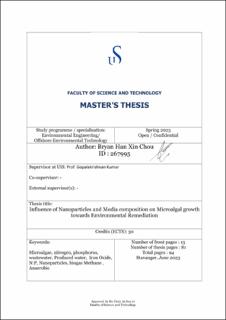| dc.description.abstract | Scenedesmus sp. is one type of freshwater microalgae widely studied due to its robustness and versatility in growth, high nutrient removal and lipid production, making it a potential candidate as a renewable energy source and wastewater remediation. This helps with the increasing world population and energy demand.
Scenedesmus sp was used in a ten-day bioremediation study on various wastewater (WW): Dissolved air flotation (DAF) and Sequencing Batch Reactors (SBR) effluent, and offshore Produced water (PW), mixed with Bold’s base medium (BBM) into five dilutions: Control (BBM only), 25 50, 75 and 100% of WW. Scenedesmus sp. grew in all WW with some variation in biomass production and nutrient removal efficiency (RE). Growing in SBR WW resulted in optimal conditions with the highest biomass produced and highest Total Nitrogen (TN) RE of more than 76% despite competitive results from DAF WW. Diluting 75% of SBR WW with BBM showed the most optimal dilution condition, attaining a decent TN and the highest Total Phosphorous (TP) RE of 76.3% and 82.4%. Using only 25% or 100% of SBR is not recommended due to being less cost-effective and being subjected to nitrogen limitation conditions at high WW volume.
Adding metal nanoparticles (NP) in low dosage demonstrated positive outcomes but inhibition at high concentrations. 75% SBR dilution was chosen for the addition of eight Fe3O4 NP concentrations: Control (without NP), 1, 2.5, 5, 10, 25, 50 and 100 mg/l of NP. Results showed improved biomass production and nutrient RE and extreme tolerance toward Fe3O4. The addition of 2.5mg/l NP resulted in the highest biomass of 3129.6mg/l and the highest TN and TP RE of 89% and 94%, respectively, meeting the nutrient RE requirement from the European Union (EU) regulations. Observation can also conclude that increasing NP concentration decreases growth and biomass production but increases nutrient RE.
The synergy in biofuel production with WW remediation achieved waste and pollutant reduction with energy recovery, promoting sustainable economics. Furthermore, NP-induced stress contributes to biogas production improvement. This was examined with the four biomass produced: Control (without NP), 2.5, 25 and 100mg/l of NP. The addition of 2.5 and 25mg/l of NP resulted in an improvement of 25% more biogas production but a 13% reduction in the presence of 100mg/l of NP. Overall, all samples produced more than 74 % methane content.
In conclusion, adding 2.5 mg/l of Fe3O4 NP to Scenedesmus sp. cultivation in SBR WW resulted in optimal biomass production, nutrient removal, and improvement in biogas production. | |
